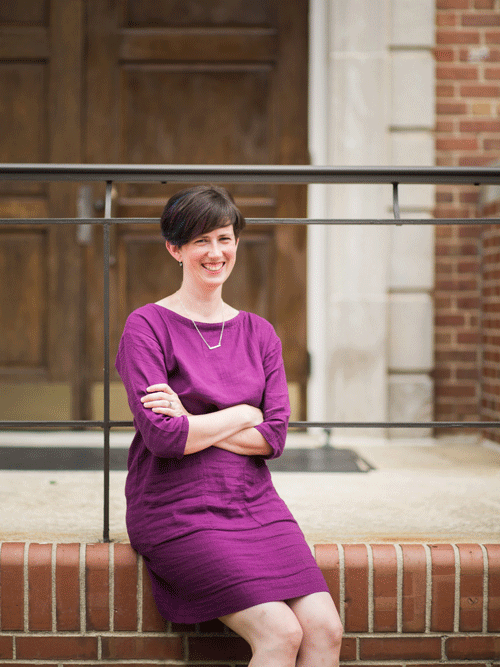The broad question that drives my research is how biological function emerges from structure and mechanics. A native North Carolinian, I was an undergraduate in the NC State Physics Department when my interest in the intersection of physics and biology was first sparked in the Weninger Lab. I then completed my PhD in Applied Physics at Stanford University, where, in the Spudich Lab, I modularly engineered myosin molecular motors to explain how molecular structure leads to mechanical function. After graduate school, I developed an interest in how biological macromolecules self-organize to generate force at the cellular, rather than molecular, length-scale. I joined the Dumont Lab at the University of California, San Francisco, where I probed physical forces present during cell division and their molecular basis by developing mechanical assays in live cells to target the architecture of the mitotic spindle, the machine that segregates chromosomes when cells divide.
I was thrilled to return to my alma mater in Fall 2017 as an Assistant Professor in the Department of Physics at NCSU. In my lab, we ask how molecular-scale cytoskeletal architectures self-organize to produce the cellular-scale function of the mitotic spindle. Our approach uses mechanical and molecular perturbations inside live mammalian and fission yeast cells to probe how microtubule architectures in cell division machinery generate force.
I'm also a member of the Quantitative and Computational Developmental Biology cluster. Collaboration and interdisciplinarity has always been central to my approach to science. I'm excited for my lab to take this opportunity to begin applying our tools to understanding how biological force scales not only from the molecular to the cellular level, but also between cells and across tissues.
Papers
Laser ablation reveals the impact of Cdc15p on the stiffness of the contractile ring. Moshtohry *, Bellingham-Johnstun *, Elting †, and Laplante †, MBoC 2022.
Force by minus-end motors Dhc1 and Klp2 collapses the S. pombe spindle after laser ablation. Zareiesfandabadi and Elting, Biophys J 2022.
K-fiber bundles in the mitotic spindle are mechanically reinforced by Kif15. Begley, Solon, Davis, Sherrill, Ohi, and Elting, MBoC 2021.
Viscoelastic Relaxation of the Nuclear Envelope Does Not Cause the Collapse of the Spindle After Ablation in S. pombe. Zareiesfandabadi and Elting, JURP, 2021.
Automated tracking of S. pombe spindle elongation dynamics. Uzsoy, Zareiesfandabadi, Jennings, Kemper and Elting, J Micro, 2021.
Cytoskeletal biophysics: Passive crosslinker adapts to keep microtubule bundles on track. Elting, Current Biology, 2021.
The collapse of the spindle following ablation in S. pombe is mediated by microtubules and the motor protein dynein. Zareiesfandabadi and Elting, BioRxiv 2020.
Automated tracking of S. pombe spindle elongation dynamics. Uzsoy, Zareiesfandabadi, Jennings, Kemper and Elting, BioRxiv 2020.
K-fiber bundles in the mitotic spindle are mechanically reinforced by Kif15. Begley, Solon, Davis, Sherrill, Ohi, and Elting, BioRxiv 2020.
Knitting Ripples. Daniels and Elting, Patterns, 2020.
The Spindle: Integrating Architecture and Mechanics across Scales. Elting *, Suresh * and Dumont, Trends in Cell Biology 2018.
Mapping Load-Bearing in the Mammalian Spindle Reveals Local Kinetochore Fiber Anchorage that Provides Mechanical Isolation and Redundancy. Elting, et al. Current Biology 2017.
The chromokinesin Klp3a and microtubules facilitate acentric chromosome segregation. Karg, et al. J Cell Bio. 2017.
Force on spindle microtubule minus ends moves chromosomes. Elting *, Hueschen *, et al. J Cell Biol. 2014.
Single-molecule fluorescence imaging of processive myosin with enhanced background suppression using linear zero-mode waveguides (ZMWs) and convex lens induced confinement (CLIC). Elting et al. Opt Exp. 2013.
Future challenges in single-molecule fluorescence and laser trap approaches to studies of molecular motors. Elting & Spudich. Dev Cell. 2012.
Detailed tuning of structure and intramolecular communication are dispensable for processive motion of myosin VI. Elting et al. Biophys J. 2011.
Engineered myosin VI motors reveal minimal structural determinants of directionality and processivity. Liao et al. J Mol Biol. 2009.
Rapid Membrane Fusion of Individual Virus Particles with Supported Lipid Bilayers. Wessels et al. Biophys J. 2007.
Posts
Open positions!
Mohamed and Kim's paper is published!
Marc, Parsa, and Ana Sofia's papers are published!
Parsa's S. pombe spindle ablation preprint selected for a preLight
Preprint of Parsa's S. pombe spindle ablation paper on BioRxiv!
Preprint of Ana Sofía's spindle tracker paper on BioRxiv!
Elting Lab receives NIH R35 MIRA Grant
Preprint of Marc's k-fiber bundle paper on BioRxiv!
New lab members!
Elting lab received collaborative grant from NSF!
Ana Sofia Wins Goldwater Scholarship!
Parsa Wins 3rd Place in NCSU Physics McCormick Symposium
Parsa Recieves Summer Funding from the Office of Undergraduate Research
American Physical Society March Meeting, Boston, MA
Invited seminar at Notre Dame, Aerospace and Mechanical Engineering
Marc and Mohamed give CMB Seminar
Welcome, Shannon Harris
American Society for Cell Biology Meeting, San Diego, CA
Triangle Cytoskeleton Meeting
Two Elting lab undergrads receive PPEP Assistantships!
New lab members!
Mary Receives ORAU Ralph E. Powe Junior Faculty Enhancement Award
Microscope has arrived!
Dispatch on Mary's Current Biology paper
Welcome
